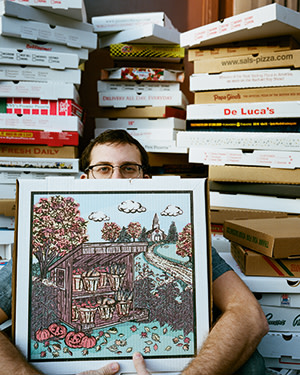First Person: Scott Wiener

Simply sign up to the Life & Arts myFT Digest -- delivered directly to your inbox.
I believe my collection of pizza delivery boxes is the largest in the world. But to be honest, I don’t think there are any other collections of pizza boxes. People just don’t do this – most boxes end up in the trash. They’re not collectors’ items – it’s like saving used tissues. But because my life revolves around pizza, to me it’s a priceless collection.
I own 597 boxes and store most of them at home.
My obsession with pizza boxes grew out of my obsession with pizza. I got really into it as a kid, growing up in New Jersey. I ate your standard, suburban, New York-style pie, with low-moisture mozzarella and a tomato-based sauce. Nothing fancy. The absolute average pizza but I loved it. It was always takeout, so it always came in a box.
In college I played guitar in a rock band and I even booked our tours based on where there was good pizza. “Hmm, I’ve never been to Chicago. I hear they have great pizza. Let’s go there.” Back home, I became the go-to person whenever anyone had a question about a pizzeria. On weekends, I’d take my friends and family to pizzerias in New York, Philadelphia, Boston. Everyone wanted to go. It got to be so many people I rented a bus. After about six months of this, I decided to make it my job. I took out my savings, got a tour-guide licence and, in 2008, launched Scott’s Pizza Tours.
A few years ago I went to Israel. Much of pizza and flatbread history comes from the Middle East, so it was a pizza research trip. While I was there I saw a yellow pizza box, and it blew my mind. Growing up, we had these thin paperboard boxes, white with a red drawing, maybe of a pizza or an Italian flag. That was it. When I saw this box in Israel – bright yellow with blue writing – I thought, “This is insane. They’re breaking all the rules!” It was like listening to punk rock for the first time. I saw how amazing pizza boxes were and how powerful they could be as an art form. I became a serious collector. I went to Italy and brought back a ton of boxes in my suitcase. I travelled to the west coast of the US and went to 52 pizzerias in 14 days. I felt like an animal.
One of my favourite boxes was designed by the artist Ed Hardy, who did a limited edition for a pizzeria in San Francisco. It’s a tattoo of a bald eagle sitting on top of a pizza with a tiger on one side and a dragon on the other. I have a box that’s perforated so that the pizza actually pops out of the top. You can make the box into a plane or a dinosaur, and the lid becomes an 80-piece jigsaw puzzle. On another box, the pizza maker in its centre looks exactly like George Clooney.
I hope the US is about to enter a golden age of pizza boxes. My book, Viva La Pizza! The Art of the Pizza Box, shows more than 100 box designs from around the world, and I’m hoping it’ll open people’s eyes to what’s possible. Italy is already having its golden age – the best pizza boxes are being made there. Japan is a close second.
New York has some of the worst pizza boxes. They’re almost all generic. They don’t value the art here because it’s not a delivery-focused market – it’s more of a single-slice culture. The best boxes in the US are on the west coast.
I actually dislike eating pizza out of boxes. I love the boxes for what they represent but for transporting pizza, they’re terrible. The box traps the pizza in steam, which breaks down the cardboard, which you then end up tasting. New pizza box technology exists but if a box costs a pizzeria even one cent more, it won’t go for it.
I realise it’s goofy to know so much about pizza boxes. It might look childish to some. But if you talk to a dentist, you want them to know everything there is to know about teeth. I treat pizza boxes the same way. They’re the most under-appreciated medium of our time.
——————————————-
‘Viva La Pizza! The Art of the Pizza Box’ is published by Melville House, £16.99
Comments